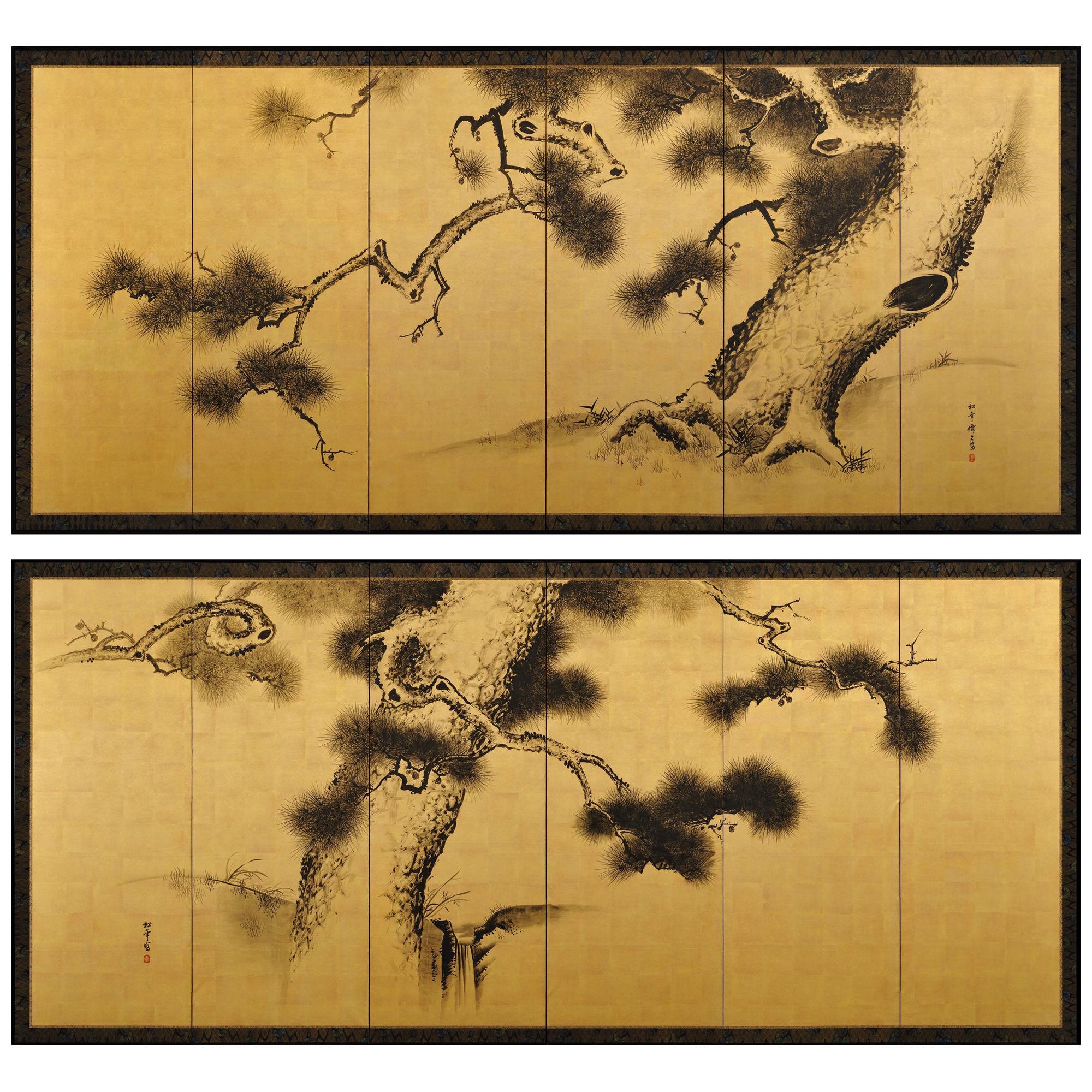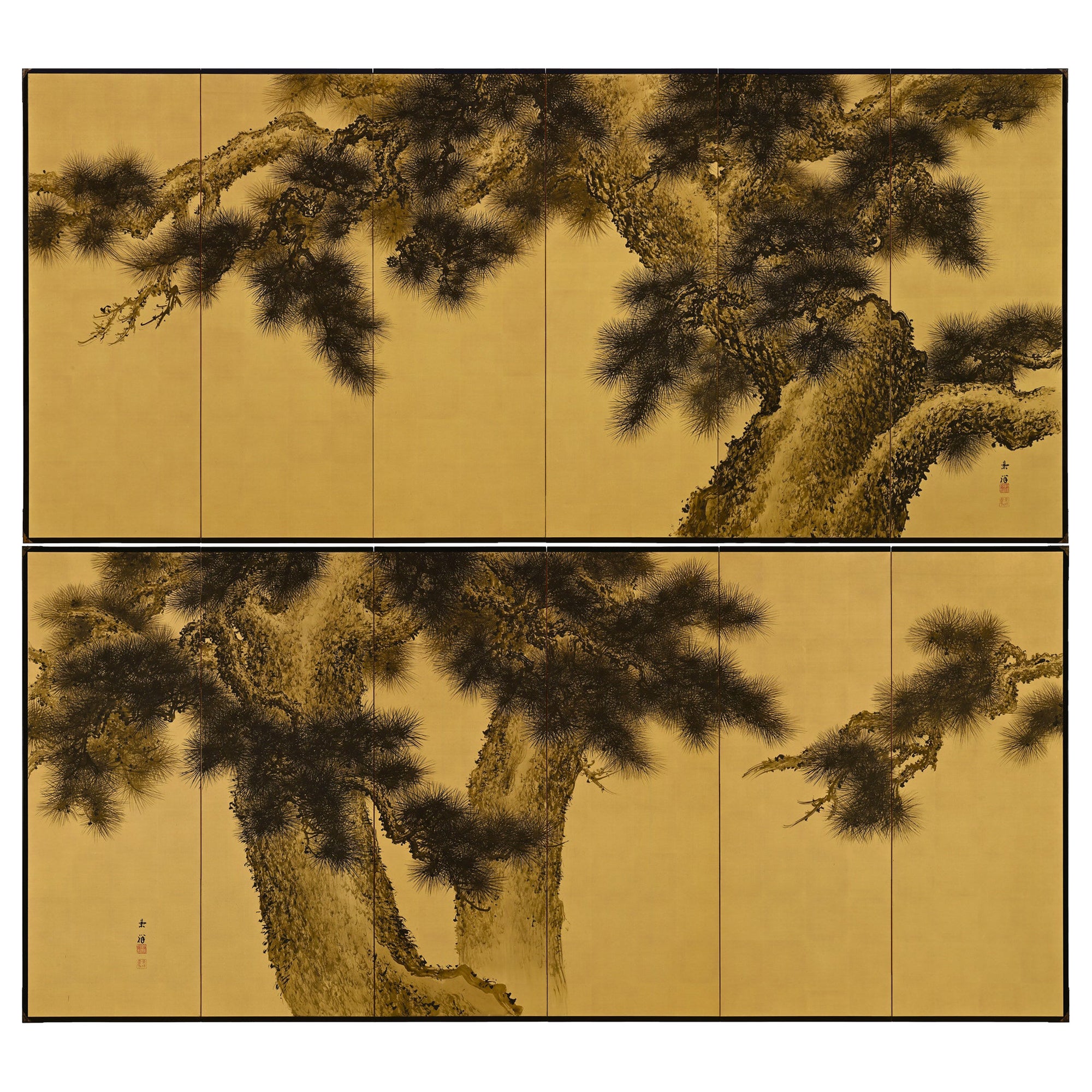Items Similar to 19th Century Small Japanese Screen Pair, Pine Trees and Vines on Gold Leaf
Want more images or videos?
Request additional images or videos from the seller
1 of 9
19th Century Small Japanese Screen Pair, Pine Trees and Vines on Gold Leaf
About the Item
This pair of screens depict just the middle sections of aged pine trees, painted in bold brush strokes on a background of gold leaf clouds. The trees are draped in vines, the lush crimson and orange hues indicating autumn. The vibrant green needles of the pines provide the perfect complement to the leaves of the vines. The composition and use of space in this work continue the bold innovations of early Kano school masters. The screens are bold and colorful, with copious use of gold. There are two types of metallic leaf employed, with the inner section showing traces of silver or a similar substance. This creates the effect of looking through a window, at a scene obscured by mist or cloud.
Free-standing, portable, and ornamented with pictorial images or calligraphy, byobu (folding screens) commonly appear in pairs, each screen consisting of two, four, six, or eight panels. In addition to providing protection from wind, folding screens serve as attractive room dividers, enclosing and demarcating private spaces in the open interiors of Japanese palaces, temples, shrines, and elite homes. When the screen is unfolded and displayed stably in a zigzag formation, the paper hinges allow the presentation of a continuous image. Screens can also be mounted directly onto a wall. Given their small size and light weight, this pair of screens are well suited to this.
Dating to the 19th century, the screens are in very good, original condition. They are signed Youshu, the seal reading Yasutoshi no in. We have been unable to discover the identity of the artist.
- Dimensions:Height: 23.5 in (59.69 cm)Width: 70.5 in (179.07 cm)Depth: 0.5 in (1.27 cm)
- Sold As:Set of 2
- Style:Edo (Of the Period)
- Materials and Techniques:
- Place of Origin:
- Period:
- Date of Manufacture:circa 1830
- Condition:The screens are in very good, original condition.
- Seller Location:Kyoto, JP
- Reference Number:1stDibs: LU2472320660542
About the Seller
5.0
Recognized Seller
These prestigious sellers are industry leaders and represent the highest echelon for item quality and design.
Gold Seller
These expertly vetted sellers are highly rated and consistently exceed customer expectations.
Established in 2001
1stDibs seller since 2016
59 sales on 1stDibs
Typical response time: 5 hours
- ShippingRetrieving quote...Ships From: Kyoto, Japan
- Return PolicyA return for this item may be initiated within 10 days of delivery.
More From This SellerView All
- Japanese Screen pair. Late 19th Century. Ink Pine Trees on Gold by Suzuki ShonenLocated in Kyoto, JPSuzuki Shonen (1848-1918) Meiji period (1868-1912), late 19th century. Twisted pines Pair of six-fold screens. Ink on a gold leaf ground. Sig...Category
Antique Late 19th Century Japanese Meiji Paintings and Screens
MaterialsGold Leaf
- Japanese Screen, 19th Century, Rabbits and Horsetail Reeds on Silver LeafBy NenmaLocated in Kyoto, JPUnknown artist Rabbits and Horsetail Reeds Painted in the Year of the Fire Dog, 1826 or 1886. 19th century. The scene depicted here is set under moonlight, with two hares hi...Category
Antique Mid-19th Century Japanese Edo Paintings and Screens
MaterialsSilver Leaf
- Early 20th Century Japanese Screen Pair - Ink Pine Trees on GoldLocated in Kyoto, JPImao Keisho (1902-1993) Pine Trees Early 20th Century, Circa 1930 Pair of six-panel Japanese screens. Ink on silk and gold leaf. Dimensions: Each screen H. 67.5” x 148” (172 cm x 376 cm) A pair of monumental six-panel Japanese pine screens by the renowned Nihonga artist Imao Keisho. Here Keisho entirely removed the background and brought the pine trees to the surface of the painting. This simplification of the elements makes the scene exceptionally direct and compelling and injects a very modern...Category
Early 20th Century Japanese Showa Paintings and Screens
MaterialsGold Leaf
- 19th Century Japanese Screen for Tea-Ceremony, Ink Bamboo and Plum on Gold LeafLocated in Kyoto, JPThree Friends of Winter Nakajima Raisho (1796-1871) Late Edo period, circa 1850 Ink and gold leaf on paper. This is a double-sided Japanese Furosaki or tea-ceremony screen from the mid 19th century; bamboo and plum on the front, young pines the back. It by Nakajima Raisho, a master painter of the Maruyama school in the late Edo and early Meiji periods. In this work Raisho combines exquisite ink brushwork with large open spaces of brilliant gold-leaf to inspire the viewers imagination. Rather than naturalism, he is searching for the phycological impression of the motifs, resulting in abstraction and stylization. His simplification of the motifs the result of looking to capture the inner nature of the objects. This art motif is known as Sho Chiku Bai, or the Three Friends of Winter. Evergreen pine connotes steadfastness, bamboo suggests both strength and flexibility, while plum blossoms unfurling on snow-laden branches imply hardiness. Combined, this trio is emblematic of Japanese new year. Chinese literati were the first to group the three plants together due to their noble characteristics. Like these resilient plants flowering so beautifully in winter, it was expected of the scholar-gentleman to cultivate a strong character with which he would be able to show the same degree of perseverance and steadfastness even during times of adverse conditions. The screen would have been placed near the hearth of a room used for the Japanese tea ceremony, shielding the fire from draughts and also forming a stimulating and decorative backdrop behind the tea utensils. It would have been used in the Hatsugama, or first tea-ceremony of the new year. Nakajima Raisho (1796-1871) originally studied under Watanabe Nangaku before entering the school of Maruyama Ozui. He was the highest ranking Maruyama school painter at the end of the Edo period and was known as one of the ‘Four Heian Families’ along with Kishi...Category
Antique Mid-19th Century Japanese Edo Paintings and Screens
MaterialsGold Leaf
- 17th Century Japanese Screen Pair by Soga Nichokuan, Hawks on Pine & Plum TreesLocated in Kyoto, JPHawks on plum and pine Soga Nichokuan (active circa 1625-1660) Pair of six-fold screens. Ink, mineral pigments, gofun, gold and speckled gold leaf on paper. Upper seal: H...Category
Antique 1640s Japanese Edo Paintings and Screens
MaterialsWood, Paper
- 17th Century Japanese Screen Pair, CranesLocated in Kyoto, JPCranes Anonymous, Kano School. Edo period, second half of the 17th century. Pair of six-panel screens. Ink, pigment gofun and gold l...Category
Antique 1670s Japanese Edo Paintings and Screens
MaterialsGold Leaf
You May Also Like
- Edo Period 19th Century Japanese Folding Screen Six Panels Flowers on Gold LeafBy Rimpa SchoolLocated in Brescia, ITClouds of gold, water and many colorful flowers: Japanese six-panel folding screen by Rimpa School. Hand painted with rice mineral pigments and inks on rice paper and gold leaf.Category
Antique Early 19th Century Japanese Edo Paintings and Screens
MaterialsGold Leaf
- Six-Panel Japanese Screen on Spring Gold LeafLocated in Brescia, ITSpring landscape by an unknown painter of the Rinpa school, 19th century, six-panel ink painted on gold leaf on rice paper. The flowers are made with the "gofun" technique, natural or pigmented white oyster powder. Rinpa (? ?, Rinpa) is one of the major historical schools of Japanese painting. the style was consolidated by the brothers Ogata Korin (1658–1716) and Ogata Kenzan...Category
Antique Late 19th Century Japanese Edo Paintings and Screens
MaterialsGold Leaf
- Japanese Folding Screen Six Panels Painted on Gold LeafBy Japanese StudioLocated in Brescia, ITParavento a sei pannelli di scuola giapponese Kano: paesaggio con bellissime ed eleganti gru vicino al fiume, con alberi di pino e sakura. Dipinto a mano con pigmenti minerali ed inc...Category
Antique Early 19th Century Japanese Edo Paintings and Screens
MaterialsGold Leaf
- Japanese Two Panel Screen Young Pine and Pine Cones on GoldLocated in Hudson, NYMineral pigments on gold leaf on mulberry paper with a silk brocade border.Category
Antique Early 1800s Japanese Paintings and Screens
MaterialsBrocade, Silk, Paper
- 19th Century Japanese Edo Six Panel Kano School Landscape ScreenLocated in Rio Vista, CALate Edo period 19th century Japanese six-panel landscape screen featuring a cypress tree over a flowering hibiscus with a pair of hototogisu birds. Kano school painted with ink and ...Category
Antique 19th Century Japanese Edo Paintings and Screens
MaterialsSilk, Wood, Paper
- Japanese Screen of Spring on Gold LeafLocated in Brescia, ITIt is a two-panel screen from the Taisho period, around 1920, beautifully painted in excellent detail. The best of Rinpa's school painting: large empty space that highlights a pair of mandarin ducks in the middle of the pond. On the right, flying birds give the painting a great lightness, under many multicolored flowers they celebrate spring. All very proportionate and pleasant, the dimension really interesting. Mineral pigments on gold leaf. It turns out Anonymous. Lucio Morini.Category
Early 20th Century Japanese Taisho Paintings and Screens
MaterialsGold Leaf





